Governor of California
| Governor of California | |
|---|---|
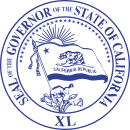 Seal of the Governor of California | |
 Standard of the Governor | |
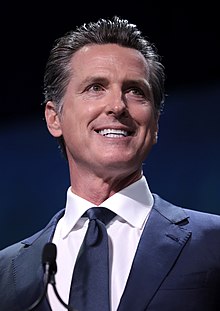 Gavin Newsom since January 7, 2019 | |
| Style | The Honorable (formal) |
| Residence | California Governor's Mansion |
| Seat | Sacramento, California |
| Term length | Four-year term, renewable once |
| Inaugural holder | Peter Hardeman Burnett |
| Formation | December 20, 1849 |
| Salary | US$210,000 (2020)[1] |
| Website | Official website |
The governor of California is the head of government of the U.S. state of California. The governor is the commander-in-chief of the California National Guard and the California State Guard.
Established in the Constitution of California, the governor's responsibilities also include making the annual State of the State address to the California State Legislature, submitting the budget, and ensuring that state laws are enforced. The position was created in 1849, the year before California became a state.
The current governor of California is Democrat Gavin Newsom, who was inaugurated on January 7, 2019.
Gubernatorial elections, oath, and term of office[]
Qualifications[]
A candidate for governor must be a U.S. citizen and a registered voter within the state. He or she must not have been convicted of a felony involving bribery, embezzlement, or extortion, and must not have served two terms since November 6, 1990.[2]
Election and oath of Governor[]
Governors are elected by popular ballot and serve terms of four years, with a limit of two terms, if served after November 6, 1990.[3] Governors take the following oath:
I (Governor) do solemnly swear that I will support and defend the Constitution of the United States and the Constitution of the State of California against all enemies foreign and domestic, that I will bear true faith and allegiance to the Constitution of the United States and the Constitution of the State of California, that I take this obligation freely without any mental reservation or purpose of evasion and that I will well and faithfully discharge the duties upon which I am about to enter.
Governors take office on the first Monday after January 1 after their election.
Gubernatorial removal[]
There are two methods of removing a governor before the expiration of his or her term:
Impeachment and removal by the legislature[]
The governor can be impeached for "misconduct in office" by the State Assembly and removed by a two-thirds vote of the State Senate.
Recall by the voters[]
Petitions signed by California state voters equal to 12% of the last vote for the office of governor (with signatures from each of five counties equal to 1% of the last vote for Governor in the county) can launch a gubernatorial recall election. The voters can then vote on whether or not to recall the incumbent Governor, and on the same ballot can vote for a potential replacement.
If a majority of the voters in the election vote to recall the Governor, then the person who gains a plurality of the votes in the replacement race will become Governor.
The 2003 California gubernatorial recall election began with a petition drive that forced Democratic Governor Gray Davis into a recall election. It was the first time that a California governor was voted out of office. He was replaced by Republican Arnold Schwarzenegger.
Current governor Gavin Newsom faced a recall election which he defeated on September 14th, 2021.[4]
Relationship with the Lieutenant Governor[]
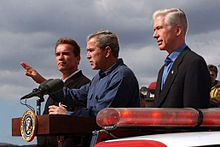
The Lieutenant Governor of California is separately elected during the same election, not jointly as the running mate of the gubernatorial candidate. As such, California had a Governor and a Lieutenant Governor of different parties for 28 of the 33 years between 1978 and 2011, whereas previously, this had only occurred in 1875, 1886, 1894 and 1916-1917 due to the resignation or death of an incumbent Governor or Lieutenant Governor.
This occasionally becomes significant, since the California Constitution provides that all the powers of the Governor fall to the Lieutenant Governor whenever the governor is not in the state of California, with the Lieutenant Governor sometimes signing or vetoing legislation or making political appointments whenever the Governor leaves the state.
In practice, there is a gentlemen's agreement for the Lieutenant Governor not to perform more than perfunctory duties while the Governor is away from the state: this agreement was violated when Mike Curb was in office, as he signed several executive orders at odds with the Brown administration when Brown was out of the state. Court rulings have upheld the Lieutenant Governor's right to perform the duties and assume all of the prerogatives of Governor while the Governor is out of the state.[5]
The Lieutenant Governor is also the president of the California State Senate.
Gubernatorial facts[]
This section is in list format but may read better as prose. (November 2018) |
This section contains a list of miscellaneous information. (November 2018) |
Official residence and workplace[]
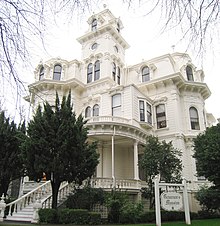
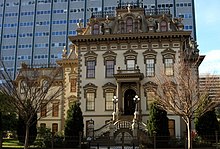
The official residence of Californian governor is the California Governor's Mansion, in Sacramento. The mansion has served as the residence of 14 governors, while others have declined to reside in the mansion, preferring to arrange for private residential arrangements. It is also one of the official workplaces for the governor.
The governor's primary official workplace is located within the California State Capitol in Sacramento.
The Stanford Mansion, in Sacramento, serves as one of the official workplaces for the governor, as well as the official reception center for the California government.
Age and longevity[]

- Peter Burnett had the longest post-governorship, 44 years. He left office in 1851 and died in 1895.
- Excluding governors who died in office, Robert Waterman had the shortest post-governorship. He died on April 12, 1891, a short three months and four days after the expiration of his term.
- Sworn in at the age of 30, J. Neely Johnson was the youngest governor from 1856 to 1858.
- Sworn in at the age of 72, Jerry Brown was the oldest governor from 2011 to 2019.
- Earl Warren was the only governor to serve more than two consecutive terms in office (1943–1953).
- Jerry Brown previously served as governor for eight years (1975–1983) and returned to office 28 years later to serve as governor for another eight years (2011–2019).
- Milton Latham served the shortest term in office of five days (January 9–14, 1860).
- Of the 38 governors who served in office, only eight were actually born in California (seven after statehood):
- One (Romualdo Pacheco) was born in Santa Barbara.
- Five (George Pardee, James Rolph, Pat Brown, Jerry Brown, and Gavin Newsom) were born in San Francisco.
- One (Hiram Johnson) was born in Sacramento.
- One (Earl Warren) was born in Los Angeles.
- Two governors were born outside the United States:
- John G. Downey was born in Ireland.
- Arnold Schwarzenegger was born in Austria.
- Only two governors have died in office:
- Washington Bartlett on September 12, 1887
- James Rolph on June 2, 1934
- Ronald Reagan had the longest life-span of any governor, 93 years.
- J. Neely Johnson had the shortest life-span of any governor, 47 years.
- Both governors who died in office, Washington Bartlett in 1887 and James Rolph in 1934, served as Mayor of San Francisco shortly before becoming governor.
- Two governors are related:
- Pat Brown (1959–1967) was the father of twice-governor Jerry Brown (1975–1983, 2011–2019).
Transition events[]
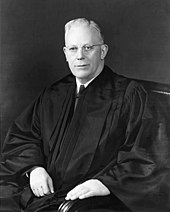

- Five governors have resigned:
- Peter Burnett in 1851 "as a result of certain personal prejudices" regarding prevention of slavery by excluding all African-Americans[6]
- Milton Latham in 1860 to become a United States Senator
- Newton Booth in 1875 to become a United States Senator
- Hiram Johnson in 1917 to become a United States Senator
- Earl Warren in 1953 to become Chief Justice of the United States
- One governor has been recalled:
- Gray Davis in 2003
- One governor has won a recall election:
- Gavin Newsom in 2021
- Seven governors took office without being elected to the governor's seat, having been elected as lieutenant governor and then ascending from that position:
- Four of them did not run to succeed themselves, and were never elected governor:
- John McDougal in 1851
- John G. Downey in 1860
- Romualdo Pacheco in 1875
- Robert Waterman in 1887
- The other three later ran for governor, and were elected to succeed themselves as governor:
- William Stephens in 1917
- Frank Merriam in 1934
- Goodwin Knight in 1953
- Four of them did not run to succeed themselves, and were never elected governor:
- One governor has served two terms, and was elected to a non-consecutive third term (followed by a fourth term):
- Jerry Brown in 2010 (Brown is the only living former governor of California who was elected to two terms before term limits were enacted on November 6, 1990)
Presidential campaigns[]
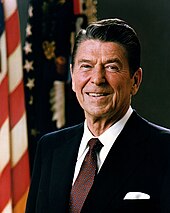
- One former governor of California won his party's nomination and was elected President of the United States:
- Ronald Reagan in 1980 and 1984 (Republican)
- Five governors actively sought the nomination of their party, but were unsuccessful:
- Hiram Johnson in 1920 and 1924 (Republican)
- Pat Brown in 1960 (Democratic)
- Ronald Reagan in 1968 and 1976 (Republican)
- Jerry Brown in 1976, 1980 and 1992 (Democratic)
- Pete Wilson in 1996 (Republican)
- Earl Warren in 1944, 1948 and 1952 (Republican)
- Two governors were nominated for Vice President, but their ticket lost the election:
- Hiram Johnson (Ran with Theodore Roosevelt, Progressive, 1912)
- Earl Warren (Ran with Thomas Dewey, Republican, 1948)
- Two governors did not run for president, but were under serious consideration by their party's nominee during their governorship to be their running mate for the office of Vice President, but were not chosen:
- George Deukmejian (George H.W. Bush, Republican, 1988) declined being considered because of his vast ideological differences with Lieutenant Governor Leo McCarthy, who would have become governor if Deukmejian accepted the nomination and was elected to the Vice Presidency.[7]
- Gray Davis (Al Gore, Democratic, 2000)
- One unsuccessful candidate for governor of California was elected President of the United States:
- Former Vice President Richard Nixon was the Republican nominee for Governor of California in 1962, and lost to Democrat Pat Brown. Nixon later was elected president in 1968 and reelected in 1972 (Republican).
See also[]
- List of governors of California
- List of governors of California before 1850
- List of governors of California by education
- Politics of California
- Politics of California before 1900
- Spouses of the governors of California
- List of burial places of governors of California
- List of California state agencies
References[]
- ^ "Gavin Newsom Is Highest-Paid Governor In The United States". October 22, 2019.
- ^ "Summary of Qualifications and Requirements for the Offices of Governor and Lieutenant Governor | California Secretary of State". www.sos.ca.gov.
- ^ Shelley, Kevin (October 2003). "Summary of Qualifications and Requirements for the Office of Governor" (PDF). California Secretary of State Department. Archived from the original (PDF) on November 28, 2008. Retrieved February 23, 2009.
- ^ "California Gov. Gavin Newsom stays in power as recall fails". AP NEWS. September 14, 2021. Retrieved September 15, 2021.
- ^ In re Governorship, 26 Cal.3d 110, 401 (Supreme Court of California 1979) ("we conclude that the Lieutenant Governor has authority to exercise all gubernatorial powers of appointment while the Governor is physically absent from the state and that the Governor has authority to withdraw the appointment until the confirmation of appointment becomes effective.").
- ^ Alastair Dallas (June 5, 2004). "Governors of California: 1849–2003". familydallas.com. Archived from the original on March 8, 2005. Retrieved March 10, 2016.
- ^ "Californian Removes Himself From Running for No. 2 Spot". The New York Times. August 5, 1988.
External links[]
| Wikimedia Commons has media related to Governors of California. |
- Governor of California
- 1849 establishments in California

